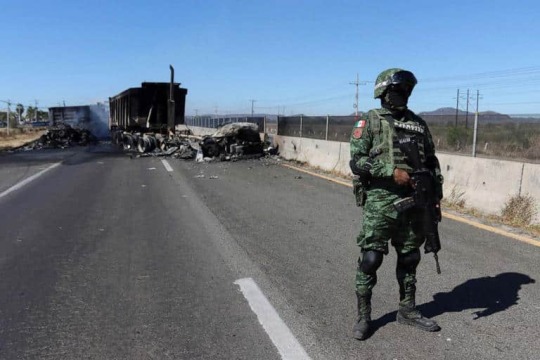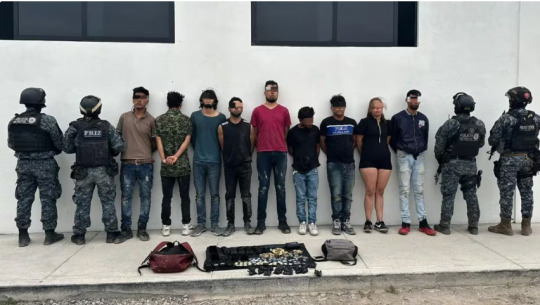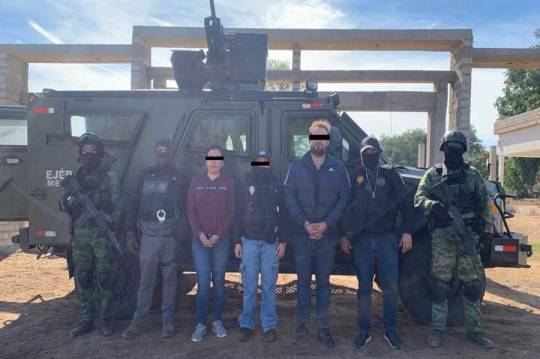#cartel de sinaloa
Text
Ovidio Guzmán, hijo de ElChapo, detenido
Ovidio Guzmán, hijo de ElChapo, detenido
El hijo del infame narcotraficante mexicano, El Chapo, ha sido detenido. Ovidio Guzmán fue detenido por las autoridades mexicanas antes de la visita del presidente de Estados Unidos, Joe Biden.
En respuesta a la detención de Guzmán, el cartel de Sinaloa ha lanzado una ofensiva contra el ejército mexicano. Han establecido barricadas para evitar su escape y han participado activamente en…

View On WordPress
#autoridades mexicanas#cartel de Sinaloa#culiacán#detenido#ejército mexicano#ElChapo#Estados Unidos#Hijo#Joe Biden#Mexico#narcotráfico#noticias#Ovidio Guzmán#telerelard#violencia
7 notes
·
View notes
Text
El reconocido especialista Ricardo Buscaglia aseguro que el cartel de Sinaloa opera en varias provincias y CFK no tuvo voluntad de investigar
Edgardo Buscaglia investigó la situación criminal en 119 países. Recordó que en 2011 trabajó en Rosario y el gobierno nacional no se interesó por el combate al crimen organizado
Edgardo Buscaglia investigó la situación criminal en 119 países. Recordó que en 2011 trabajó en Rosario y el gobierno nacional no se interesó por el combate al crimen organizado
Exclusivo: Narcos en La Matanza: Asesinan…

View On WordPress
#2011#Cartel de Sinaloa#Chapo Guzman#cristina kirchner#ninguna investigación#Opera en Argentina#Reconocido especialista#Ricardo Buscaglia#Varias provincias
3 notes
·
View notes
Text

Ya sabran de la camisa , Pues Arriba la Chapisa!!
#LaChapisa#cartel de sinaloa#buchon#corridos#gerardo ortiz#michoacan#ak-47#cuernos de chivo#culiacan#soyelraton#cha🍕
5 notes
·
View notes
Text
Detienen a nueve del Cártel de Sinaloa en Zacatecas, uno de ellos es originario de EEUU
Luego de que durante el pasado domingo 5 de mayo hubo vehículos quemados en Zacatecas, agentes de seguridad lograron la captura de nueve personas, al parecer ligadas al Cártel de Sinaloa, entre las que se encuentra un menor de edad que es originario de Estados Unidos.
Durante el lunes 6 de mayo las autoridades informaron el arresto de las nueve personas quienes son considerados…

View On WordPress
0 notes
Text
Capturan a jefe del Cártel de Sinaloa que enviaba drogas sintéticas a EE.UU., Europa y Australia

View On WordPress
0 notes
Text
Légende, Part 3.
Manuel !
Si ?
Ca te dirais de venir manger à la maison ce soir, ma femme fait super bien les enchiladas !
Apprendre à les connaitre, se faire des amis si possible et surtout repérer les failles dans leur système. Il ne devait pas seulement obtenir des informations spécifiques sur El Mayo, lui et les autres devaient détruire toute une filière qui remontait jusqu’à Dubaï. Il ne savait pas…

View On WordPress
#Cartel de Juarez#cartel de Sinaloa#Cartel del Golfo#cocaïne#infiltration#Ismaël Zambada aka El Mayo#Légende part 1#Légende part 2#Los Zetas#Mexique#polar#torture#trafic de drogue
0 notes
Text
México lamenta asesinato de Fernando Villavicencio
México lamenta asesinato de Fernando Villavicencio
#PeriodismoParaTi #SociedadNoticias
#Ecuador #Asesinato #Candidato #AMLO #Conferencia #Mañanera #ConferenciaPresidente #Mañanera @GobiernoMX @lopezobrador_
López Obrador dijo no tener información de que el Cártel de Sinaloa haya sido el autor de asesinato del candidato presidencial del Ecuador.
Por Carlos Lara Moreno | Reportero
El presidente Andrés Manuel López Obador lamentó el asesinato del candidato presidencial del Ecuador, Fernando Villavicencio y lo comparó con el magnicidio de Luis Donaldo Colosio en 1994 en México.
Asesinan a tiros a…

View On WordPress
#AMLo#Candidato asesinado#Cartel de Sinaloa#Cdmx#Conferencia AMLO#Conferencia presidente#Ecuador#México#Morena#Secretaría de Gobernación#SN#Sociedad#Sociedad Noticias#Sociedad-Noticias.com#sociedadNoticias#SociedadNoticias.com
0 notes
Text
Por 'cooperación extraordinaria' con autoridades, liberan a El Mini Lic
Por ‘cooperación extraordinaria’ con autoridades, liberan a El Mini Lic
Luego de días de especulación, se dio a conocer públicamente que Dámaso López Serrano alias ‘El Mini Lic’ fue liberado el viernes, ya que cumplió con su condena y brindó información crucial a las autoridades sobre el Cártel de Sinaloa y Joaquín ‘El Chapo’ Guzmán.
‘El Mini Lic’ es hijo de Dámaso López Núñez alias El Licenciado. Fue un miembro de importancia en el Cártel de Sinaloa y se considera…

View On WordPress
1 note
·
View note
Text
Salma Paola Sánchez, balancing the position of Governess of Sinaloa next to being the head of the greatest drug empire in Central America.


Filling the boots of her grandfather, whom the cartel had been snapped out of his cold hands by his rival over ten years ago, which led to the Sánchez family fleeing to the US, Sánchez is a cold, calculating and merciless Dona. After some lonely years in a Texan school, a Juilliard school drama degree and years of bloodthirsty plan making and scheming, Sánchez returned to her hometown Mazatlán in Mexico, to retake the cartel and Sinaloa with all the good warriors of her legacy who were left, hand in hand with the next, her own, generation. And now, after years of careful rehabilitation and reconstruction, the cartel booms and blooms in all its glory.

Recently, Sánchez has been elected to be the honorable Governadora de Sinaloa, equally challenging her light next to her darker shades.
#— (la vida sangrienta de la jefa; sinaloa cartel) 𝕯𝖔𝖓𝖆 𝕯𝖎𝖆𝖇𝖑𝖆#— (she is wine of love; every drop poisoning the hearts of men) 𝕬𝖕𝖕𝖊𝖆𝖗𝖆𝖓𝖈𝖊#— (veneno méxicano) 𝕾𝖆𝖑𝖒𝖆 𝕻𝖆𝖔𝖑𝖆 𝕾𝖆́𝖓𝖈𝖍𝖊𝖟#userfakevz#crime
37 notes
·
View notes
Text
Here's the complete list of DHS flagged search terms. Don't use any of these on social media to avoid having the 3-letter agencies express interest in your activities!
DHS & Other Agencies
Department of Homeland Security (DHS)
Federal Emergency Management Agency (FEMA)
Coast Guard (USCG)
Customs and Border Protection (CBP)
Border Patrol
Secret Service (USSS)
National Operations Center (NOC)
Homeland Defense
Immigration Customs Enforcement (ICE)
Agent
Task Force
Central Intelligence Agency (CIA)
Fusion Center
Drug Enforcement Agency (DEA)
Secure Border Initiative (SBI)
Federal Bureau of Investigation (FBI)
Alcohol Tobacco and Firearms (ATF)
U.S. Citizenship and Immigration Services (CIS)
Federal Air Marshal Service (FAMS)
Transportation Security Administration (TSA)
Air Marshal
Federal Aviation Administration (FAA)
National Guard
Red Cross
United Nations (UN)
Domestic Security
Assassination
Attack
Domestic security
Drill
Exercise
Cops
Law enforcement
Authorities
Disaster assistance
Disaster management
DNDO (Domestic Nuclear Detection Office)
National preparedness
Mitigation
Prevention
Response
Recovery
Dirty Bomb
Domestic nuclear detection
Emergency management
Emergency response
First responder
Homeland security
Maritime domain awareness (MDA)
National preparedness initiative
Militia
Shooting
Shots fired
Evacuation
Deaths
Hostage
Explosion (explosive)
Police
Disaster medical assistance team (DMAT)
Organized crime
Gangs
National security
State of emergency
Security
Breach
Threat
Standoff
SWAT
Screening
Lockdown
Bomb (squad or threat)
Crash
Looting
Riot
Emergency Landing
Pipe bomb
Incident
Facility
HAZMAT & Nuclear
Hazmat
Nuclear
Chemical Spill
Suspicious package/device
Toxic
National laboratory
Nuclear facility
Nuclear threat
Cloud
Plume
Radiation
Radioactive
Leak
Biological infection (or event)
Chemical
Chemical burn
Biological
Epidemic
Hazardous
Hazardous material incident
Industrial spill
Infection
Powder (white)
Gas
Spillover
Anthrax
Blister agent
Exposure
Burn
Nerve agent
Ricin
Sarin
North Korea
Health Concern + H1N1
Outbreak
Contamination
Exposure
Virus
Evacuation
Bacteria
Recall
Ebola
Food Poisoning
Foot and Mouth (FMD)
H5N1
Avian
Flu
Salmonella
Small Pox
Plague
Human to human
Human to ANIMAL
Influenza
Center for Disease Control (CDC)
Drug Administration (FDA)
Public Health
Toxic
Agro Terror
Tuberculosis (TB)
Agriculture
Listeria
Symptoms
Mutation
Resistant
Antiviral
Wave
Pandemic
Infection
Water/air borne
Sick
Swine
Pork
Strain
Quarantine
H1N1
Vaccine
Tamiflu
Norvo Virus
Epidemic
World Health Organization (WHO and components)
Viral Hemorrhagic Fever
E. Coli
Infrastructure Security
Infrastructure security
Airport
CIKR (Critical Infrastructure & Key Resources)
AMTRAK
Collapse
Computer infrastructure
Communications infrastructure
Telecommunications
Critical infrastructure
National infrastructure
Metro
WMATA
Airplane (and derivatives)
Chemical fire
Subway
BART
MARTA
Port Authority
NBIC (National Biosurveillance Integration Center)
Transportation security
Grid
Power
Smart
Body scanner
Electric
Failure or outage
Black out
Brown out
Port
Dock
Bridge
Canceled
Delays
Service disruption
Power lines
Southwest Border Violence
Drug cartel
Violence
Gang
Drug
Narcotics
Cocaine
Marijuana
Heroin
Border
Mexico
Cartel
Southwest
Juarez
Sinaloa
Tijuana
Torreon
Yuma
Tucson
Decapitated
U.S. Consulate
Consular
El Paso
Fort Hancock
San Diego
Ciudad Juarez
Nogales
Sonora
Colombia
Mara salvatrucha
MS13 or MS-13
Drug war
Mexican army
Methamphetamine
Cartel de Golfo
Gulf Cartel
La Familia
Reynose
Nuevo Leon
Narcos
Narco banners (Spanish equivalents)
Los Zetas
Shootout
Execution
Gunfight
Trafficking
Kidnap
Calderon
Reyosa
Bust
Tamaulipas
Meth Lab
Drug trade
Illegal immigrants
Smuggling (smugglers)
Matamoros
Michoacana
Guzman
Arellano-Felix
Beltran-Leyva
Barrio Azteca
Artistics Assassins
Mexicles
New Federation
Terrorism
Terrorism
Al Queda (all spellings)
Terror
Attack
Iraq
Afghanistan
Iran
Pakistan
Agro
Environmental terrorist
Eco terrorism
Conventional weapon
Target
Weapons grade
Dirty bomb
Enriched
Nuclear
Chemical weapon
Biological weapon
Ammonium nitrate
Improvised explosive device
IED (Improvised Explosive Device)
Abu Sayyaf
Hamas
FARC (Armed Revolutionary Forces Colombia)
IRA (Irish Republican Army)
ETA (Euskadi ta Askatasuna)
Basque Separatists
Hezbollah
Tamil Tiger
PLF (Palestine Liberation Front)
PLO (Palestine Libration Organization)
Car bomb
Jihad
Taliban
Weapons cache
Suicide bomber
Suicide attack
Suspicious substance
AQAP (Al Qaeda Arabian Peninsula)
AQIM (Al Qaeda in the Islamic Maghreb)
TTP (Tehrik-i-Taliban Pakistan)
Yemen
Pirates
Extremism
Somalia
Nigeria
Radicals
Al-Shabaab
Home grown
Plot
Nationalist
Recruitment
Fundamentalism
Islamist
Weather/Disaster/Emergency
Emergency
Hurricane
Tornado
Twister
Tsunami
Earthquake
Tremor
Flood
Storm
Crest
Temblor
Extreme weather
Forest fire
Brush fire
Ice
Stranded/Stuck
Help
Hail
Wildfire
Tsunami Warning Center
Magnitude
Avalanche
Typhoon
Shelter-in-place
Disaster
Snow
Blizzard
Sleet
Mud slide or Mudslide
Erosion
Power outage
Brown out
Warning
Watch
Lightening
Aid
Relief
Closure
Interstate
Burst
Emergency Broadcast System
Cyber Security
Cyber security
Botnet
DDOS (dedicated denial of service)
Denial of service
Malware
Virus
Trojan
Keylogger
Cyber Command
2600
Spammer
Phishing
Rootkit
Phreaking
Cain and abel
Brute forcing
Mysql injection
Cyber attack
Cyber terror
Hacker
China
Conficker
Worm
Scammers
Social media
SOCIAL MEDIA?!
20 notes
·
View notes
Text
being the arellano baby and being into ismael "mayo" zambada would include (the wedding cont.)

a/n: has to get this out of my head and dump it here
okay i had this idea stuck in my head
the last part ended with this moment of like benjamin and ramon at odds
benjamin was out here trying to butter mayo up and have you dance with him and at the same time, ramon is sicking his dogs on you to keep you away from mayo
and if this wasn't the representation of your life, watching on the sidelines as like wtf while the boys make these decisions for you
and the idea that stuck in my head was just like what if in that moment you snapped
you had lived your who life being calm, agreeable and this, this just made you snap
so kitty is wrapping his arm around you, guiding you away from mayo who is measuring his next move and you just stop
"no, no, no dejame" you protests, shaking kitty off but when he comes off to grab you by the elbow that's when you truly fucking pop off
"no me escuchastes? get the fuck out of my way, en serio. i'm an arellano-felix just as much as my brothers are dont fucking forget it"
the fucking look on literally everyone's faces when you reminded people who's fucking twin you were
kitty lowering his glasses, giving ramon this look before turing to you with a little like damn girl smirk "orale, perdoname patrona"
i swear dina is in the background with this big ol fucking smile on her face
and you kinda turning around to mayo who is standing there with arms crossed shaking his head in lowkey amazement
"pues, mi princesa, por lo menos ya se quien realmente manda aqui" he teases as he reaches out to you with this little teasing look
you reaching out to grab his hand, him pulling you into him with much less hesitancy now and slinging his arm around your waist as he leads you to go dance
i just pout of getting to the dance floor and he bring you up against him gently, slow dancing to luis miguel and you just kinda melting into him
i'm screaming, head pressed against him and him leaning down to whisper something like "i could get used to this" or or something about like "quizas puedo dejar de ser mi propio patron, solo si tu eres la patrona"
i will never and i mean never get over the thought of mayo calling you his patrona because he will always defer to you
when they stopped the music to transition to the speeches and stuff, you and mayo being the last ones on the dance floor and you being pulled away by one of your sister
"ahorita te la regreso" she'd tease mayo and i just the logging looks you give each others please kill me
okay but then we get to that fucking moment in the speeches, where the poor fucking soul from the sinaloa cartel who was like "and a toast to the eight inches she'll be swallowing" or some shit like that
but could you picture if he added something about baby arellano too if he added something about "and i have some inches the youngest can choke on, don't worry nena"
i'm screeching at the idea of mayo slamming his fucking fist down on the table and standing to like death glare this man almost just almost as fast as ramon gets up to fucking take care of it
dina and benjamin escorting you to go sit down, mayo i just :(( coming over to you and reaching his hand out to caress your face making sure you're okay
thumb going softly across your cheek and he's searching your face "ay, nos encargamos de esto, no te preocupas, reina"
and him winking at you before turning and just casually walking out the door not far behind ramon and his juniors
why do i have this idea of mayo being the kind of man that would want to bring you out and have this piece of shit apologize to you
like holding this guys head up, blowing smoke in his face and being like "pidale perdon, mas bien ruega que te perdona porque yo no"
anyways i'll leave this here
#narcos mexico headcannons#narcos mexico#ismael el mayo zambada#el mayo x reader#ramon arellano felix#benjamin arellano felix
96 notes
·
View notes
Text


Cecilia Patricia Flores Armenta known as Ceci Flores is a Mexican human rights activist. She is the founder and leader of Madres Buscadoras de Sonora y de México (searching mothers of Sonora) – a group of women searching for missing or disappeared people in Mexico. Two of Flores’ six children were kidnapped in 2019.
Ceci Flores is from Northern Mexico. Her son, Alejandro along with his boss disappeared in Los Mochis, Sinaloa in 2015. In 2019, two of her children Marco Antonio and Jesús Adrián aged 15 were kidnapped by a cartel. Flores identified one of the men who kidnapped her two sons and threatened him to return her sons. Days later Adrián was released but his brother Antonio remains missing to date.
The search for her son led Flores and other women searching for missing family members to found Searching Mothers of Sonora. The group organize search parties with anti-kidnapping unit of the police but police was inefficient due to lack of fuel and frequent break down of patrol vehicles. In 2021, Flores and her group abandoned the police and decided to reach out directly to the cartels in Sinaloa and Sonora by posting messages on social media making different requests to the cartel. In one of the messages, Flores made a plea to the cartels: “I’m reaching out to the leaders of the cartels. We’re not looking for justice, all we want is to find our missing loved ones and give them a proper burial,”. The group then posted a specific message on social media requesting the cartels to allow them search La Bartolina, a mass gravesite close to the U.S. border on the Gulf Coast. They asked the cartels to drop a banner by the border fence if they approve their request to search the forest for missing people. Days later, a banner was found and the Searching Mothers went into the forest where they discovered and excavated a mass grave containing human skeletons.
Later, this method was adopted by other groups searching for missing people but the government of President Andrés Manuel López Obrador was piqued and accused the searching mothers of colluding with cartels and opposition groups against his government. Flores responded in a video message posted to social media stating that “If I have to go to hell itself, I’ll do it. And if I have to ask narcos for help, I’ll do that too.” On 17 April 2023, Flores was disappeared. President Andrés Manuel López Obrador ordered troops to start an operation to locate her. She was found 15 hours after her disappearance

24 notes
·
View notes
Text

Néstor Isidro Pérez, "El Nini", exjefe de seguridad de los Chapitos
Néstor Isidro Pérez, „El Nini“, ehemaliger Sicherheitschef der Chapitos
La facción de los Chapitos del Cartel de Sinaloa ha tenido un año difícil, con varias detenciones de alto nivel, extradiciones a Estados Unidos y luchas internas en todo México. Sin embargo, es poco probable que estos contratiempos supongan el fin del grupo.
El golpe más reciente se produjo a finales de noviembre, cuando la Guardia Nacional de México capturó a Néstor Isidro Pérez, alias «El Nini». Se le acusa de ser el jefe de seguridad de los Chapitos y de trabajar directamente para Iván Archivaldo Guzmán Salazar, uno de los varios hijos del exlíder del Cartel de Sinaloa, Joaquín Guzmán Loera, alias «El Chapo«, que lideran esa facción del grupo.
Isidro Pérez era uno de los múltiples miembros de los Chapitos en la mira del gobierno estadounidense este año. Antes de su captura, fiscales de Washington D. C. y Nueva York lo habían acusado de narcotráfico en 2021 y 2023. El Departamento de Estado también ofreció una recompensa de hasta 3 millones de dólares por cualquier información que condujera a su captura.
Die Chapitos-Fraktion des Sinaloa-Kartells hatte ein schwieriges Jahr mit mehreren Verhaftungen auf hoher Ebene, Auslieferungen an die Vereinigten Staaten und internen Machtkämpfen in ganz Mexiko. Es ist jedoch unwahrscheinlich, dass diese Rückschläge das Ende der Gruppe bedeuten.
Der jüngste Putsch ereignete sich Ende November, als die mexikanische Nationalgarde Néstor Isidro Pérez, alias „El Nini“, gefangen nahm. Ihm wird vorgeworfen, der Sicherheitschef der Chapitos zu sein und direkt für Iván Archivaldo Guzmán Salazar zu arbeiten, einen der mehreren Söhne des ehemaligen Anführers des Sinaloa-Kartells, Joaquín Guzmán Loera, alias „El Chapo“, der diese Fraktion anführte aus der Gruppe. .
Isidro Pérez war eines der vielen Mitglieder von Los Chapitos, die in diesem Jahr von der US-Regierung ins Visier genommen wurden. Vor seiner Festnahme hatten ihn Staatsanwälte in Washington, D.C. und New York wegen Drogenhandels in den Jahren 2021 und 2023 angeklagt. Das Außenministerium setzte außerdem eine Belohnung von bis zu 3 Millionen US-Dollar für alle Informationen aus, die zu seiner Festnahme führten.
Su detención no es más que el último revés sufrido por la poderosa facción del Cartel de Sinaloa. El grupo se ha enfrentado a una mayor presión durante 2023 por parte de los gobiernos estadounidense y mexicano.
A principios de enero de 2023, las autoridades mexicanas detuvieron por segunda vez a Ovidio Guzmán López en Culiacán, la base de los Chapitos en Sinaloa. Esta vez consiguieron retenerlo. En abril fue acusado por la fiscalía estadounidense y extraditado rápidamente a Chicago en septiembre.
Guzmán López presuntamente había encabezado la expansión de las operaciones de tráfico de drogas de los Chapitos, especialmente de fentanilo, el letal opioide sintético responsable de miles de muertes por sobredosis en Estados Unidos. Unos meses más tarde, en mayo, la Marina mexicana detuvo a Héctor Elías Flores Aceves, alias «El 15», otro jefe de los Chapitos que se encargaba de la venta de droga en Cancún, una zona turística de Quintana Roo. También se detuvo a otros líderes en Sonora.
Seine Verhaftung ist nichts weiter als der jüngste Rückschlag, den die mächtige Fraktion des Sinaloa-Kartells erlitten hat. Die Gruppe sah sich im Jahr 2023 zunehmendem Druck seitens der US-amerikanischen und mexikanischen Regierung ausgesetzt.
Anfang Januar 2023 nahmen mexikanische Behörden Ovidio Guzmán López zum zweiten Mal in Culiacán, dem Stützpunkt der Chapitos in Sinaloa, fest. Diesmal gelang es ihnen, ihn zu behalten. Im April wurde er von US-Anwälten angeklagt und im September umgehend an Chicago ausgeliefert.
Guzmán López soll die Ausweitung des Drogenhandels der Chapitos vorangetrieben haben, insbesondere mit Fentanyl, dem tödlichen synthetischen Opioid, das in den Vereinigten Staaten für Tausende von Todesfällen durch Überdosis verantwortlich ist. Einige Monate später, im Mai, verhaftete die mexikanische Marine Héctor Elías Flores Aceves, alias „El 15“, einen weiteren Anführer der Chapitos, der für den Drogenverkauf in Cancún, einem Touristengebiet von Quintana Roo, verantwortlich war. Auch andere Anführer in Sonora wurden festgenommen.
Con la crisis del fentanilo imponiéndose en la agenda política en Estados Unidos, por la presión implacable de la opinión pública en ese país, los líderes de los Chapitos prohibieron todo tráfico y producción de fentanilo en Sinaloa en junio. Al parecer, otras células del Cartel de Sinaloa en Sonora y Baja California Sur acordaron seguir su ejemplo, pero no todas las facciones del grupo lo hicieron.
«Cuando te digo que está prohibido, es en serio. Está prohibido», dijo un sicario afiliado a los Chapitos a en septiembre.
Para quienes no acataron la prohibición, las consecuencias fueron fatales. En Culiacán, un comandante de un gran grupo independiente de producción de drogas sintéticas y un jefe de seguridad afiliado a los Chapitos dijeron recientemente a que, entre junio y septiembre, el grupo ejecutó al menos a 50 personas por desobedecer la orden.
Los conflictos internos por el tráfico de drogas sintéticas también desataron violencia extrema en otras partes del país. Desde octubre, varias facciones del Cartel de Sinaloa se enfrentan a lo largo de la frontera entre México y Estados Unidos, en Sonora, por el tráfico de drogas y las rutas de contrabando de migrantes a través del desierto.
Da die Fentanyl-Krise aufgrund des unerbittlichen Drucks der öffentlichen Meinung in diesem Land immer mehr auf die politische Tagesordnung der Vereinigten Staaten rückte, verbot die Führung von Chapitos im Juni den gesamten Handel und die Produktion von Fentanyl in Sinaloa. Andere Zellen des Sinaloa-Kartells in Sonora und Baja California Sur stimmten offenbar zu, diesem Beispiel zu folgen, aber nicht alle Fraktionen der Gruppe taten dies.
„Wenn ich Ihnen sage, dass es verboten ist, dann meine ich es auch so. Es ist verboten“, sagte ein mit den Chapitos verbundener Auftragsmörder im September.
Für diejenigen, die sich nicht an das Verbot hielten, waren die Folgen fatal. In Culiacán sagte kürzlich ein Kommandeur einer großen unabhängigen Gruppe zur Herstellung synthetischer Drogen und ein mit den Chapitos verbundener Sicherheitschef, dass die Gruppe zwischen Juni und September mindestens 50 Menschen wegen Missachtung des Befehls hingerichtet habe.
Interne Konflikte um den Handel mit synthetischen Drogen führten auch in anderen Teilen des Landes zu extremer Gewalt. Seit Oktober kam es entlang der US-mexikanischen Grenze in Sonora zu Auseinandersetzungen verschiedener Fraktionen des Sinaloa-Kartells wegen Drogenhandel und Migrantenschmuggelrouten durch die Wüste.
Y las alianzas están cambiando rápidamente. Una antigua filial del Cartel de Sinaloa, conocida como los Cazadores, se ha atomizado después de la separación de su brazo armado, los Deltas, para operar de manera independiente. Desde entonces, los Cazadores han formado una nueva facción, los Alfas, para enfrentar a los Deltas, que han unido fuerzas con un grupo local llamado los Pelones. Los Chapitos apoyan ahora la alianza Deltas-Pelones contra la coalición independiente Cazadores-Alfas.
Cuando Isidro Pérez fue detenido en noviembre, los Chapitos ya estaban en problemas. Al día siguiente de su detención, unos desconocidos mataron a tiros a Eduardo Escobedo, un convicto narcotraficante conocido como «El Mago», en Los Ángeles, California. En algún momento, este fue un importante distribuidor de marihuana para Guzmán Salazar y los Chapitos, según documentos judiciales estadounidenses.
Aún no está claro si el asesinato tuvo algo que ver con la detención de Isidro Pérez o con las luchas internas dentro de la cúpula de los Chapitos, pero marcó el colofón de un año tumultuoso para una de las principales facciones del Cartel de Sinaloa.
Und Allianzen verändern sich rasant. Ein ehemaliger Ableger des Sinaloa-Kartells, bekannt als die Cazadores, hat sich nach der Abspaltung seines bewaffneten Flügels, der Deltas, aufgelöst, um unabhängig zu operieren. Seitdem haben die Hunters eine neue Fraktion, die Alphas, gegründet, um den Deltas entgegenzutreten, die sich mit einer lokalen Gruppe namens Pelones zusammengeschlossen haben. Los Chapitos unterstützen nun die Deltas-Pelones-Allianz gegen die unabhängige Cazadores-Alfas-Koalition.
Als Isidro Pérez im November verhaftet wurde, steckten die Chapitos bereits in Schwierigkeiten. Am Tag nach seiner Festnahme erschossen Unbekannte Eduardo Escobedo, einen verurteilten Drogenhändler namens „El Mago“, in Los Angeles, Kalifornien. Laut US-Gerichtsdokumenten war dies einst ein wichtiger Marihuana-Händler für Guzmán Salazar und die Chapitos.
Es ist immer noch unklar, ob der Mord etwas mit der Verhaftung von Isidro Pérez oder mit Machtkämpfen innerhalb der Chapitos-Führung zu tun hatte, aber er markierte den Höhepunkt eines turbulenten Jahres für eine der Hauptfraktionen des Sinaloa-Kartells.
Análisis
La facción de los Chapitos es uno de los actores criminales más activos de México y del Cartel de Sinaloa, y a pesar de sus problemas actuales, es poco probable que eso cambie.
La extradición de Guzmán López y la detención de Isidro Pérez y otros altos dirigentes el año pasado probablemente provocaron cambios significativos en la cúpula de los Chapitos, pero los expertos afirman que esto no afectará a la capacidad operativa del grupo.
«Los ajustes serán en el círculo más cercano. No veo que haya una estructura que pueda disputarles el poder», opinó Javier Oliva Posada, coordinador del Seminario Universitario de Estudios sobre Democracia, Defensa, Dimensiones de la Seguridad e Inteligencia de la Universidad Nacional Autónoma de México (UNAM).
Analyse
Die Chapitos-Fraktion ist einer der aktivsten kriminellen Akteure in Mexiko und im Sinaloa-Kartell, und trotz ihrer aktuellen Probleme ist es unwahrscheinlich, dass sich daran etwas ändert.
Die Auslieferung von Guzmán López und die Verhaftung von Isidro Pérez und anderen hochrangigen Führungskräften im vergangenen Jahr führten wahrscheinlich zu erheblichen Veränderungen in der Chapitos-Führung, Experten gehen jedoch davon aus, dass dies keinen Einfluss auf die operative Leistungsfähigkeit der Gruppe haben wird.
„Die Anpassungen werden im engsten Kreis stattfinden. „Ich sehe keine Struktur, die ihre Macht herausfordern kann“, sagte Javier Oliva Posada, Koordinator des Universitätsseminars zu Studien zu Demokratie, Verteidigung, Dimensionen von Sicherheit und Geheimdienst an der Nationalen Autonomen Universität von Mexiko (UNAM).
Varios grupos criminales, al ver a los Chapitos debilitados y distraídos por las luchas internas, pueden tratar de sacar provecho de ello y ampliar sus propias operaciones delictivas. Entre los buitres que circulan están las redes asociadas al Cartel Jalisco Nueva Generación (CJNG), posiblemente el rival más formidable del Cartel de Sinaloa, así como el Cartel de Caborca y varias facciones internas del Cartel de Sinaloa.
Una de las células más fuertes de Sinaloa son los Rusos, que cuentan con el apoyo de Ismael Zambada García, alias «El Mayo», uno de los últimos miembros de la vieja guardia del Cartel de Sinaloa. Como jefe de seguridad, Isidro Pérez estuvo en el centro de la lucha de los Chapitos contra los Rusos a lo largo de la frontera entre EE.UU. y México en Baja California y Sonora.
Pero los expertos no consideran que su arresto sea una apertura suficiente para que los Rusos, o cualquier otro grupo, la exploten. La capacidad de los Chapitos para mantener el control sobre estos corredores estratégicos no depende de un lugarteniente irremplazable.
Verschiedene kriminelle Gruppen, die sehen, dass die Chapitos durch Machtkämpfe geschwächt und abgelenkt sind, könnten versuchen, ihre eigenen kriminellen Operationen auszunutzen und auszuweiten. Unter den im Umlauf befindlichen Geiern befinden sich Netzwerke, die mit dem Jalisco New Generation Cartel (CJNG), dem wohl größten Rivalen des Sinaloa-Kartells, sowie dem Caborca-Kartell und verschiedenen internen Fraktionen des Sinaloa-Kartells in Verbindung stehen.
Eine der stärksten Zellen in Sinaloa sind die Russen, die von Ismael Zambada García, alias „El Mayo“, einem der letzten Mitglieder der alten Garde des Sinaloa-Kartells, unterstützt werden. Als Sicherheitschef stand Isidro Pérez im Mittelpunkt des Kampfes der Chapitos gegen die Russen entlang der Grenze zwischen den USA und Mexiko in Baja California und Sonora.
Doch Experten halten seine Verhaftung nicht für eine ausreichende Gelegenheit, die die Russen oder andere Gruppen ausnutzen könnten. Die Fähigkeit der Chapitos, die Kontrolle über diese strategischen Korridore zu behalten, hängt nicht von einem unersetzlichen Leutnant ab.
«Me sorprendería mucho que [la detención de Isidro Pérez] tuviera algún tipo de efecto más amplio de debilitamiento real de los Chapitos», dijo Vanda Felbab-Brown, miembro senior de la Brookings Institution. «Creo que es una molestia para ellos; podría tener repercusiones temporales en frentes de batalla particulares, pero no creo que sea de ninguna manera fatal».
Esto se debe a que los Chapitos cuentan con numerosas células armadas presentes en todo México, algunas con años de experiencia operativa. Cuentan con la ayuda de estrechos vínculos con políticos corruptos y miembros de las fuerzas de seguridad que les ayudan a controlar su territorio. Mientras los gobiernos estadounidense y mexicano sigan centrando sus esfuerzos en detener a los principales líderes criminales, dejando intacta esta extensa red, los Chapitos deberían ser capaces de mantener su dominio.
«No estamos viendo realmente ningún desmantelamiento sistemático de la capacidad operativa más amplia, la expansión económica o el poder político de los Chapitos», comentó Felbab-Brown.
„Ich wäre sehr überrascht, wenn [die Verhaftung von Isidro Pérez] irgendeine weitreichendere Wirkung hätte und die Chapitos tatsächlich schwächt“, sagte Vanda Felbab-Brown, Senior Fellow an der Brookings Institution. „Ich denke, es ist ein Ärgernis für sie; „Es könnte vorübergehende Auswirkungen auf bestimmte Fronten haben, aber ich glaube nicht, dass es tödlich sein wird.“
Dies liegt daran, dass die Chapitos über zahlreiche bewaffnete Zellen in ganz Mexiko verfügen, von denen einige über jahrelange Einsatzerfahrung verfügen. Ihnen helfen enge Verbindungen zu korrupten Politikern und Angehörigen der Sicherheitskräfte, die ihnen bei der Kontrolle ihres Territoriums helfen. Solange die Regierungen der USA und Mexikos ihre Bemühungen weiterhin auf die Verhaftung der führenden Kriminellen konzentrieren und dieses umfangreiche Netzwerk intakt lassen, sollten die Chapitos in der Lage sein, ihre Vorherrschaft aufrechtzuerhalten.
„Wir sehen nicht wirklich einen systematischen Abbau der breiteren operativen Kapazität, der wirtschaftlichen Expansion oder der politischen Macht der Chapitos“, sagte Felbab-Brown.
2 notes
·
View notes
Text
In my previous column, I outlined how the government of President Andrés Manuel López Obrador steadily hollowed out U.S.-Mexico security and counternarcotics cooperation despite the vast flows of fentanyl from Mexico to the United States. In this column, I discuss why the insistence of the López Obrador administration that it alone will take care of counternarcotics measures in Mexico is problematic and lacks credibility. Drawing on my recent statement for the record for the U.S. House of Representatives hearing “Follow the Money: The CCP’s Business Model Fueling the Fentanyl Crisis,” I detail U.S. policy options vis-à-vis Mexico to induce better anti-drug and security cooperation.
The evisceration of U.S.-Mexico security cooperation by the López Obrador administration did not come out of the blue. It is part and parcel of the Mexican government’s abdication of security policies and internal responsibilities in Mexico.
At the beginning of his administration, President López Obrador announced a strategy of “hugs, not bullets” toward criminal groups that sought to emphasize socio-economic programs to deal with crime, and address the causes that propel young people to join criminal groups.
But that strategy never articulated any security or law enforcement policy toward criminal groups. Worse, as Mexican criminal groups have resorted to more and more brazen violence and impunity, dramatically expanded the range of legal economies they seek to take over and dominate, and intensified their efforts to influence elections, the López Obrador administration has persisted in its do-little policy.
Essentially, the Mexican president has hoped that if he does not interfere with Mexico’s criminal groups, they will eventually redivide Mexico’s economies and territories among themselves and violence will subside. That policy has been disastrous for many reasons: Most importantly, because it throws the rule of law in Mexico underneath the bus of impunity and subjects Mexican people, institutions, and legal economies to the tyranny of Mexican criminal groups. But also because Mexico’s out-of-control criminal market, plagued by a bipolar and increasingly internationalized war between the Sinaloa Cartel and CJNG, has little chance at such stabilization.
Like other Mexican presidents since the 1980s, López Obrador reshuffled Mexican security institutions. Most significantly, he abolished the Federal Police and created a National Guard staffed mostly by Mexican soldiers and police officers from the former Federal Police.
However, the National Guard is not and could never be an adequate replacement for the Federal Police. President López Obrador dismantled the Federal Police because of its infiltration by Mexican criminal groups, a systematic and pervasive problem for all of Mexico’s law enforcement forces for decades. Since the 1980s, the many iterations of law enforcement reforms have failed to expunge such infiltration and corruption across Mexican agencies.
However, the Federal Police, with all its faults, also had the greatest investigative capacities and mandates. The National Guard has no investigative mandates and very little capacity: It can only act as a deterrent force by patrolling the streets, something that it has not been effective at, or acting against crime in flagrancia. A Mexican lawyer in a conversation with me in 2021 summed it up well: “The National Guard are the most expensive mannequins in Mexico.”
Investigative authorities in Mexico are predominantly the role of the Office of the Attorney General (Fiscalía General de la República, FGR), the Federal Ministerial Police and state prosecutorial offices. But their capacities are limited, all are overwhelmed by the level of crime in Mexico, and all of them have also suffered from criminal infiltration despite decades-long efforts at reform.
Moreover, what remains unanswered and unexamined regarding the law enforcement reforms of the López Obrador administration is the question of what has happened to all of the equipment, technologies, and databases (such as Plataforma Mexico), and the intelligence that the United States provided the Federal Police with under the $3.5 billion aid package of the Mérida Initiative? Who owns this equipment now: the National Guard? The Mexican military? What accountability has there been for U.S. taxpayers’ money, especially as the López Obrador administration gutted meaningful counternarcotics cooperation even as over one hundred thousand Americans are dying of drug overdose and over thirty thousand Mexicans from homicides?
With the lack of will on the part of the Mexican government and the lack of capacities of Mexican law enforcement institutions to take on the cartels, it is not satisfactory to operate on President López Obrador’s preferred definition of U.S.-Mexico cooperation: the United States countering the flows of weapons and money to Mexico and Mexico doing what it wants, which is very little, in terms of domestic enforcement and with little transparency to boot.
On March 27, news reports began circulating that the United States and Mexico were on the verge of announcing a “new” deal concerning the fentanyl flows. Subsequent reporting from the end of March the U.S.-Mexico Synthetic Drug Conference in Mexico City rather suggested a hardening of Mexico’s noncooperation crouch.
But whether any eventually-announced renewed U.S.-Mexico cooperation will be more than thin gruel remains to be seen. If such “new” efforts mostly restate López Obrador’s interpretation of the Bicentennial Framework, cooperation will remain inadequate. To be watched is whether Mexico will become more reliable in sharing samples from declared precursor and fentanyl seizures, begins conducting controlled delivery operations, allows agents of the U.S. Drug Enforcement Administration (DEA) at least to observe and ride along on interdiction raids, and starts more systematically acting on U.S. intelligence.
Also yet to be understood is what authorities, if any, the U.S. Homeland Security Investigations (HSI) agency has and will have to operate in Mexico. As with the DEA, will HSI be able to ride along on Mexican law enforcement operations or will it be mainly focused on countering weapons and financial flows to Mexico as Mexico prefers? After the López Obrador administration shackled DEA operations in Mexico (as I detailed in my previous column) the HSI has sometimes been talked about as a replacement for DEA operations. But it is not clear – and unlikely – that HSI can do so.
U.S. counternarcotics and law enforcement bargaining with Mexico is unfortunately constrained by the U.S. reliance on Mexico to stop migrant flows to the United States. If the United States were able to conduct a comprehensive immigration reform that would provide legal work opportunities to those currently seeking protection and opportunities in the United States through unauthorized migration, it would have far better leverage to induce meaningful and robust counternarcotics and law enforcement cooperation with Mexico. Nonetheless, even absent such reform, the United States can take impactful measures.
Republican lawmakers have introduced legislation to designate Mexican cartels as Foreign Terrorist Organizations (FTO). An FTO designation would enable intelligence gathering and strike options of the United States military, such as against some fentanyl labs in Mexico or visible formations of large Mexican cartels – principally CJNG.
However, such unilateral U.S. military actions in Mexico would severely jeopardize relations with our vital trading partner and neighbor whose society is deeply intertwined with ours through familial connections. Calls for U.S. military strikes against fentanyl-linked targets in Mexico have already been condemned by Mexican government officials, politicians, and commentators.
Meanwhile, the number of available targets in Mexico would be limited. Most Mexican criminal groups do not gather in military-like visible formations. Many fentanyl labs already operate in buildings in populated neighborhoods of towns and cities where strikes would not be possible due to risks to Mexican civilians. Moreover, fentanyl labs would easily be recreated.
Nor would the FTO designation add authorities to the economic sanctions and anti-money laundering and financial intelligence tools that the already-in-place designation of Transnational Criminal Organization (TCO) carries. The latter designation also carries extensive prohibitions against material support.
But an FTO designation could significantly limit and outright hamper U.S. foreign policy options and measures. Such prohibitions of material support for designated terrorist organizations have made it difficult for the United States to implement non-military and non-law-enforcement policy measures in a wide range of countries, making it a crime to provide assistance for legal job creation or reintegration support for even populations that had to endure the rule of brutal terrorist groups. To be in compliance with the material support laws, the United States and other entities must guarantee that none of their financial or material assistance is leaking out, including through coerced extortion, to those designated as FTOs.
Yet such controls would be a significant challenge in Mexico where many people and businesses in legal economies, such as agriculture, fisheries, logging, mining, and retail, have to pay extortion fees to Mexican criminal groups. The attempted controls could undermine the ability to trade with Mexico, as many U.S. businesses would not be able to determine whether their Mexican trading or production partner was paying extortion fees to Mexican cartels, and thus guarantee that they were not indirectly in violation of material support clauses.
The FTO designation could hamper the delivery of U.S. training, such as to local police forces or Mexican federal law enforcement agencies, if guarantees could not be established that such counterparts had no infiltration by criminal actors.
Instead, if the López Obrador administration continues to deny meaningful law enforcement cooperation, the United States may have to resort to significantly intensified border inspections, even if they substantially slow down the legal trade and cause substantial damage to Mexican goods, such as agricultural products. Yes, such measures would also cause economic pains in the United States, impacting U.S. trade with Mexico and supply chains. But the U.S. opioid epidemic, fueled by fentanyl, also carries large economic costs, in addition to killing tens of thousands of Americans yearly. In 2020, the latest estimate by the U.S. Congress Joint Economic Committee put the cost of the opioid epidemic in the United States at nearly US $1.5 trillion, 37 percent higher than a 2017 estimate of the U.S. Centers for Disease Control (CDC). In contrast, in 2019, U.S. goods and services trade with Mexico totaled an estimated US $677.3 billion , with imports from Mexico $387.8 billion. With higher and growing U.S. yearly deaths since 2020, the cost of the U.S. opioid epidemic is even higher now. Thus, even the economic impact measures clearly imply that major additional efforts to save U.S. lives from lethal overdose and countering fentanyl flows are imperative.
Under optimal circumstances, U.S.-Mexico law enforcement cooperation would be robust enough to make legal border crossings fast and efficient. Joint fentanyl and precursor busts and seizures could take place near production labs and at warehouses. Joint inspections of legal cargo heading to the United States could take place close to production and loading sites in Mexico. Under the Mérida Initiative, the Obama administration, in fact, sought to develop along with Mexico such systems of legal cargo inspection inside Mexico and away from the border.
But if Mexico refuses to act as a reliable law enforcement partner to counter the greatest drug epidemic in North America, which is also decimating lives in Mexico, the United States may have to focus much intensified inspections at the border, despite the economic pains.
Furthermore, the United States can also develop packages of leverage, including indictment portfolios, against Mexican national security and law enforcement officials and politicians who undermine and sabotage rule of law cooperation with the United States. Instead of giving up on the type of arrests like that of former Mexican Secretary of Defense Gen. Salvador Cienfuegos in October 2020, the United States could double up on them.
The structural characteristics of synthetic drugs, such as fentanyl, including the ease of developing similar, but not scheduled, synthetic drugs and their new precursors, pose immense structural obstacles to controlling their supply.
U.S. domestic prevention, treatment, harm reduction, and law enforcement measures are fundamental and indispensable to countering the devastating fentanyl crisis.
However, given the extent and lethality of the synthetic opioid epidemic in North America and its likely eventual spread to other parts of the world, even supply control measures with partial and limited effectiveness can save lives and thus need to be designed as smartly and robustly as possible. They require reliable international cooperation.
The sabotage of that counternarcotics cooperation with the United States by the López Obrador administration should not be acceptable.
3 notes
·
View notes
Text
Responsabilizan al Cártel de Sinaloa por disturbios del domingo en Zacatecas
Responsabilizan al Cártel de Sinaloa por disturbios del domingo en Zacatecas

View On WordPress
0 notes
